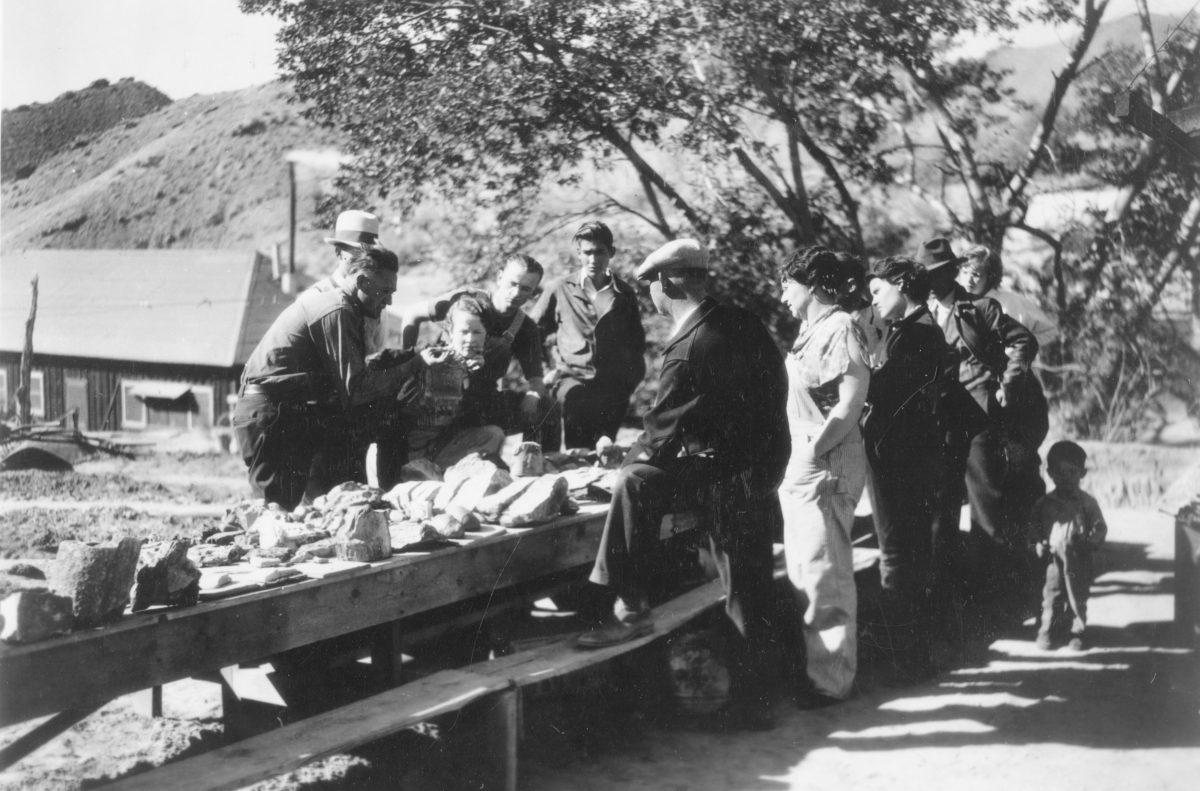In her article in the fall 2015 Utah Historical Quarterly, Susan Rhoades Neel, an associate professor of history at Utah State University tells the bittersweet story of Earl and Pearl Douglass. Earl Douglass worked his way from a meager Minnesota childhood to become a scientist for the Carnegie Museum and discover, in 1909, the deposit of fossils that would become Dinosaur National Monument. Along the slow road to these accomplishments, Earl met Pearl Goetschius, whom he married in 1905. Together they founded a homestead in the Uintah Basin called Dinosaur Ranch.
In the following interview, Neel shares her reaction to conducting research in the Douglass Papers at the University of Utah’s Marriott Library, approach to telling rich stories, and reflections on the broader meaning of the Douglasses in eastern Utah. We also asked about how her scholarship and teaching in environmental history and the national park system informed her work on the Douglasses. The Q&A is followed by early photographs of Dinosaur National Monument from the collection of the Utah State Historical Society (USHS).
How did you come to the subject of Earl Douglass and his personal life?
I first encountered Earl Douglass years ago when I was doing research on the debate in the 1950s over the proposal to construct a dam in Dinosaur National Monument. That debate was an important milestone in the emergence of the modern environmental movement. It seemed like I should know something about how the area became a national monument in the first place. As an undergraduate I’d worked in the manuscripts division of the Marriott Library, and I knew they held a collection of papers from the paleontologist who first discovered the fossils at Dinosaur
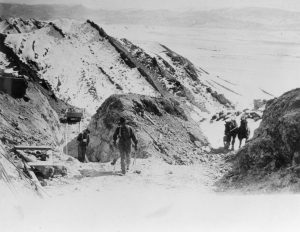
This east-facing view shows the opening of the quarry at Dinosaur National Monument in 1910. The work was done with blasting powder, hand drills, a team and scrapers, picks, and shovels. In this image, the fossil-bearing layer is to the left of the cut. Photograph by A. S. Coggeshall; gift of Dinosaur National Monument. USHS classified photograph collection.
National Monument, so that seemed a good place to start.
As I dove into the huge collection of Douglass papers, I was struck by the richness of the record—diaries, notebooks, personal and professional correspondence, reams of poetry, essays, and miscellaneous musings. These documents were quite a contrast in tone to the official government agency memos and reports that made up most of my research on the Echo Park dam controversy.
For me, history, at its core, is a bunch of really compelling stories about the human experience. A geeky paleontologist falling in love with one of his students, courting her over years through dozens of sometimes awkward and sometimes beautiful love letters, a life of personal and professional triumphs and disasters, all unfolding in two places that I personally adore, Montana and Dinosaur National Monument—it was like being in a historian’s version of a candy shop.
Of course, a good historian can’t spend all her time in the candy shop—you have to visit the salad bar, too. My task was to understand the Echo Park dam controversy, so I reluctantly set aside the Douglass family, vowing to return some day. This article is the fulfillment of that commitment.
And how did Douglass’s discoveries and work influence perceptions of wilderness and nature in the later debates over Echo Park, of which you’ve written a great deal?
By the 1950s, when the debate over Echo Park took place, Earl Douglass was pretty much a forgotten man. I don’t think either the supporters or opponents of the dam knew much about him; none of the contending parties made any reference to his work in their arguments before Congress and the public.
I’m not sure what Earl would have thought about the proposed Echo Park Dam. The concept of wilderness, as we think of it today, did not exist in Douglass’s age. He rarely used the word 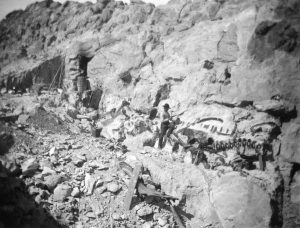 “wilderness” in his writings. He had a very nineteenth-century conception of nature. In terms of aesthetics the ideas of grandeur and the sublime seemed most compelling to Douglass, especially as a way of conceptualizing the relationship between nature, humans, and God. Like his contemporary, John Muir, Douglass sought spiritual sustenance in nature and hoped others would as well (interestingly, I found no evidence among all of Douglass’s many musings and writings that he was familiar with Muir’s work). But that didn’t necessarily mean Douglass felt places like Dinosaur National Monument should be left untouched by human activity. After all, his greatest ambition was to have a successful homestead in the area. In his last years, working as a field geologist, he sought to develop the region’s mineral resources. He also worked closely with the commercial interests in Vernal to encourage tourism, partly by building more roads in the Uintah Basin.
“wilderness” in his writings. He had a very nineteenth-century conception of nature. In terms of aesthetics the ideas of grandeur and the sublime seemed most compelling to Douglass, especially as a way of conceptualizing the relationship between nature, humans, and God. Like his contemporary, John Muir, Douglass sought spiritual sustenance in nature and hoped others would as well (interestingly, I found no evidence among all of Douglass’s many musings and writings that he was familiar with Muir’s work). But that didn’t necessarily mean Douglass felt places like Dinosaur National Monument should be left untouched by human activity. After all, his greatest ambition was to have a successful homestead in the area. In his last years, working as a field geologist, he sought to develop the region’s mineral resources. He also worked closely with the commercial interests in Vernal to encourage tourism, partly by building more roads in the Uintah Basin.
It’s important to remember that the original boundary of Dinosaur National Monument encompassed just 80 acres surrounding the fossil quarry. The government extended monument status to the quarry only to protect the excavation from possible plunder by amateur bone hunters; the scenery did not factor into the government’s action in setting the area aside as a monument. It was not until much later, during the New Deal, that the scenic Green and Yampa river canyons were added to the monument. It was only in the 1930s that some people began to suggest that the area had particular qualities, which they described as “wilderness,” that warranted preservation.
It’s hard not to become fond of our subjects—especially ones so endearing as the Douglasses. How did you maintain a critical distance when researching and writing this article?
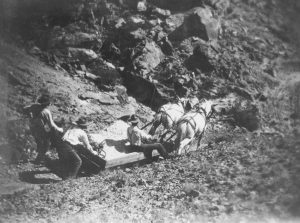
A mule team hauls a crated dinosaur specimen out of the quarry, 1910. Alf Ainge of Jensen, Utah, is the teamster. Photo by A.S. Coggeshall; gift of Dinosaur National Monument Park Service; USHS classified photograph collection.
The key to maintaining critical distance is the same for biographical studies as it is with any historical subject: stick to the story, stick to the evidence. Fondness can help motivate your work, but the task is to narrate events based on documentary sources. Attributing particular meanings to the narrative requires circumspection firmly rooted in the historical evidence on the one hand and historiography on the other. For example, I suggest that one of the formative episodes in Earl’s early life was his rejection of formalized religion and the search for a substitute spirituality in science. This was not an uncommon experience in the late nineteenth century as historians of science and of the Gilded Age have noted. The historiography helped me interpret the many documents Douglass wrote discussing his personal beliefs.
Likewise, historical studies of Victorian-era romance and courtship helped me to understand Earl’s often oblique references to women in his diaries and also the long, correspondence-based love affair between Earl and Pearl.
I have formed some personal impressions of the Douglasses, especially Earl, but I refrained from expressing them in the article because I didn’t feel there was adequate documentary evidence. And I was less confident that I could appropriately apply work by scholars in fields such as psychology to the Douglasses’ personalities or motives for particular actions—just not my area of expertise.
This article extends your previous work on the environment, tourism, and the West. How do you think Earl Douglass and
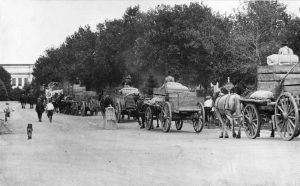
Mule teams bring wagon loads of dinosaur bones, excavated from what is now Dinosaur National Monument, to the University of Utah, 1924. USHS classified photograph collection, donated by the University of Utah Public Relations Office.
Pearl Goetschius Douglass will affect your future work?
I don’t have any particular biographical subjects in mind right now. My current interest is the role that Utah’s remarkable collection of national parks and monuments has played in the historical evolution of the national park idea. The Echo Park dam controversy was just one example of how national trends in thinking about and managing parklands played out on a Utah stage. Subsequent debates about Rainbow Bridge, Canyonlands, and most recently the Escalante-Grand Staircase have set national trends. Even in the early twentieth century, the very young state of Utah became one of the leading supporters of the national park idea. The state government supported national tourism promotion projects like the See America First campaign, the construction of regional highways systems aimed at circulating tourists through the national parks, and, of course, encouraging Utah citizens to visit the national parks.
As I do this work, I will always have Earl and Pearl in mind. They have reinforced what I’ve always known, but sometimes have too easily set aside, and
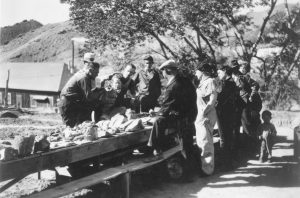
Visitors to Dinosaur National Monument looking at specimens, October 1937. Gift of Dinosaur National Monument; USHS classified photograph collection.
that is the value and pure pleasure of telling a good human story.

